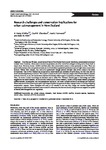Research challenges and conservation implications for urban cat management in New Zealand
| dc.contributor.author | Kikillus, KH | |
| dc.contributor.author | Chambers, GK | |
| dc.contributor.author | Farnworth, MJ | |
| dc.contributor.author | Hare, KM | |
| dc.date.accessioned | 2017-06-12T12:46:39Z | |
| dc.date.available | 2017-06-12T12:46:39Z | |
| dc.date.issued | 2017 | |
| dc.identifier.issn | 1038-2097 | |
| dc.identifier.issn | 2204-4604 | |
| dc.identifier.uri | http://hdl.handle.net/10026.1/9474 | |
| dc.description.abstract |
Over the past 20 years, conservation efforts in New Zealand have moved from being concentrated in rural and isolated island locations, where exotic mammalian predators are often controlled, to begin to bring native fauna back to major cities. However, human–wildlife conflicts arise when conservation occurs in close proximity to cities. These are particularly intense when companion animals are involved either as potential predators or prey of high-value conservation animals. Within New Zealand, this conflict is particularly fraught around domestic cats (Felis catus) in the urban environment. Cats in New Zealand are recognised as major introduced predators of native fauna, but they also prey on small introduced predatory mammals. This dynamic causes much conflict between people with different attitudes towards animals; however, as yet, few studies have explored the role(s), either negative or positive, of urban cats in New Zealand. Here, we review current knowledge on domestic cats in urban New Zealand, identify gaps in knowledge and make suggestions for future research, which includes further social science research, citizen science-based research programs, market research, investigation into cat-management legislation, and more in-depth studies of cat diseases and zoonoses. These data are vital for informing the public and improving the management of urban cat populations, including mitigating conservation impacts. Urban ecologists will need to be versatile in the way they design and conduct experiments, exploiting multiple disciplines to both ensure scientific robustness, but also community and government support for uptake of results into management and legislation. | |
| dc.format.extent | 15-15 | |
| dc.language | en | |
| dc.language.iso | en | |
| dc.publisher | CSIRO Publishing | |
| dc.title | Research challenges and conservation implications for urban cat management in New Zealand | |
| dc.type | journal-article | |
| dc.type | Review | |
| dc.type | Journal | |
| plymouth.issue | 1 | |
| plymouth.volume | 23 | |
| plymouth.publication-status | Published | |
| plymouth.journal | Pacific Conservation Biology | |
| dc.identifier.doi | 10.1071/PC16022 | |
| plymouth.organisational-group | /Plymouth | |
| dcterms.dateAccepted | 2016-10-23 | |
| dc.identifier.eissn | 2204-4604 | |
| dc.rights.embargoperiod | No embargo | |
| rioxxterms.versionofrecord | 10.1071/PC16022 | |
| rioxxterms.licenseref.uri | http://www.rioxx.net/licenses/all-rights-reserved | |
| rioxxterms.licenseref.startdate | 2017 | |
| rioxxterms.type | Journal Article/Review | |
| plymouth.oa-location | http://www.publish.csiro.au/PC/PC16022 |


